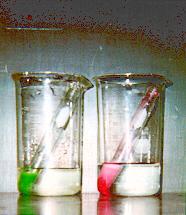How Does The Rate Of Cooling Influence Crystal Size
Demonstration goals:
- Understand the effects of cooling rate on crystal size
- Understand how rapid cooling can lead to crystal fractionalization
Thought:
When magma cools, crystals course because the solution is super-saturated with respect to some minerals. If the magma cools quickly, the crystals exercise not have much time to form, and so they are very pocket-size. If the magma cools slowly, then the crystals have enough fourth dimension to grow and get large. Some granites incorporate minerals which are up to one meter (3 ft) across!

Diorite with large Ca-feldspar crystal
The size of crystals in an igneous stone is an of import indicator of the weather condition where the rock formed. An igneous stone with large crystals probably indicates that the rock formed deep within the Earth, since information technology is typically warmer deep within the Earth than near the surface. These are calledintrusive rocks, and they have aphaneritic texture (from the Greek "phanerous" meaning visible). Similarly, a rock with pocket-size crystals probably formed at or near the surface and cooled quickly. These are calledextrusive rocks and have anaphanitic texture (from the Greek "a-" meaning not, and "phanerous"). And some magma cools and then quickly that no crystals form; nosotros say that these take a hyaline texture (from the Greek "hyalis" meaning drinking glass).

Granite with large K-feldspar crystals
Sometimes, a rock will contain both aphanitic and phaneritic crystals in information technology. This means that something truly odd happened to the magma earlier information technology was erupted. Since we know that large crystals need time to grow, the magma must have spent some time deep underground. Just the smaller crystals mean that the residual of the cooling happened very quickly. If a rock has both crystal types, it means that the mamga spent some time in a magma sleeping room, where the large crystals grew, so was violently erupted onto the surface, where the small crystals were formed. A good case of this is the Colbert Rhyolite in the Arbuckle Mountains of Oklahoma.
We tin simulate the growth of minerals using some mutual materials; simply about anybody has grown salt and carbohydrate crystals from a supersaturated solution. However, those experiments take more time than is normally available in the classroom, so we have developed a demonstration based on i given in Jackson, J. H., and E. D. Evans, 1980,Spaceship Earth: Earth Science, Revised Edition, Houghton Mifflin Company, p. 245-246.
To do this experiment, you volition need:
| Melting the mothballs and crayon mixture | Cooling the mothballs and crayon mixture |
Before the demonstration:
Fill 1 beaker with 100 mL of h2o and place it on the hot plate; bring to a boil.
Crush one of the mothballs with the pliers and identify it into a test tube; crush a crayon and add it to the test tube. Shake the test tube to mix the mothball and the crayon. Repeat, placing the other mothballs and crayons into separate examination tubes. Identify all 3 test tubes into the beaker of boiling water until the mixture melts completely.
Warning! Mothballs and crayons both requite off flammable gasses when heated. Do not place the molten mixture near an open flame or spark!
i. Using tongs, place 1 test tube into the warm water and one into the cold water at the start of class. Begin your lecture on crystal size and morphology.
2. After about ten to fifteen minutes (depending on the temperature of the warm water), remove the test tubes from the beakers. Compare the size of the crystals. You lot may need to apply a magnifying glass in order to see the crystals conspicuously; rotating the tube (to catchspecular reflection) may besides assistance.
Exercise you notice anything unusual about the crystals in the tube which was placed into cold h2o? (HINT: Is there a color change from tiptop to bottom of the test tube?)
For Discussion:
Why did the crystals grow to different sizes? Does crayon color have whatsoever effect on the crystal size? What about the relative amount of mothballs? Based on what you have discovered, can you explain why water ice foam must be churned? (Try making ice cream without churning!)
This demonstration was adapted from Jackson, J. H., and E. D. Evans, 1980,Spaceship Earth: World Science, Revised Edition, Houghton Mifflin Visitor, p. 245-246
Related pages:
An experiment with Ice Cream and Liquid Nitrogen!
The science of ice foam
How Does The Rate Of Cooling Influence Crystal Size,
Source: https://sites.northwestern.edu/sethstein/a-small-is-beautiful-approach-to-upgrading-a-beginning-geophysics-course/cooling-rate-and-crystal-size/
Posted by: boosegialren.blogspot.com




0 Response to "How Does The Rate Of Cooling Influence Crystal Size"
Post a Comment